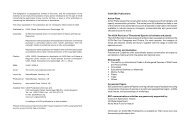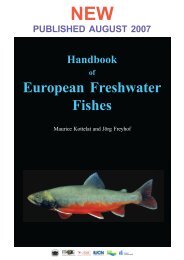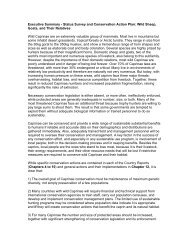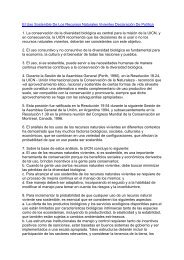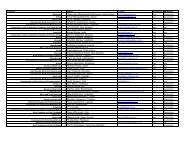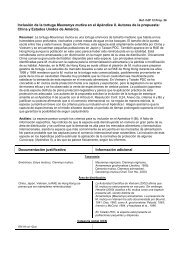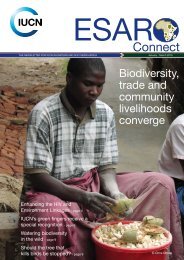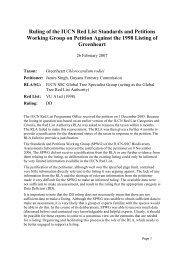Planning education to care for the earth - IUCN Knowledge Network
Planning education to care for the earth - IUCN Knowledge Network
Planning education to care for the earth - IUCN Knowledge Network
You also want an ePaper? Increase the reach of your titles
YUMPU automatically turns print PDFs into web optimized ePapers that Google loves.
Urban issues through environmental <strong>education</strong>Many people in India are already putting away newspapers, milk and o<strong>the</strong>rsachets, bottles, broken plastic and metal items which are bought by itinerantwaste collec<strong>to</strong>rs who pay on <strong>the</strong> basis of <strong>the</strong> weight of material collected. Aswell, ragpickers, usually <strong>the</strong> most destitute and children, who pickrecyclables directly from roadside bins or dumpsites are being trained <strong>for</strong>house <strong>to</strong> house collection of organic waste. In return, <strong>the</strong>y receive paymentfrom <strong>the</strong>se households <strong>for</strong> collecting organic matter, recyclables and soiledwaste in a segregated manner. They sell <strong>the</strong> recyclables <strong>to</strong> agents or retailtraders while <strong>the</strong> soiled and <strong>to</strong>xic wastes are thrown in<strong>to</strong> garbage binsprovided by <strong>the</strong> Bangalore City Corporation (BCC) <strong>for</strong> safe disposal. Asystem of collection using tricycles and at <strong>the</strong> same time motivating citizensin moni<strong>to</strong>ring garbage disposal in <strong>the</strong>ir area helps <strong>to</strong> run <strong>the</strong> programmeproperly and make it sustainable.Materials were designed <strong>for</strong> <strong>the</strong> training, on <strong>the</strong> one hand of Corporationworkers and street sweepers on <strong>the</strong> collection of garbage, separation ofsanitary and hazardous waste, <strong>care</strong>ful handling and disposal, and <strong>the</strong>harmfulness of burning, and on <strong>the</strong> o<strong>the</strong>r of rag pickers. The <strong>to</strong>pics <strong>for</strong> <strong>the</strong>latter included <strong>the</strong> collection of recyclable materials from houses, <strong>the</strong>avoidance of littering, health problems associated with picking fromgarbage bins, <strong>the</strong> composting of organic matter and <strong>the</strong> carrying of garbagebags.The volunteer communica<strong>to</strong>rs were trained <strong>to</strong> use <strong>the</strong>se materials. Aprogramme schedule and methods of communication were worked out <strong>for</strong> awide variety of target groups: shopkeepers, restaurant workers, clinic andhospital employees, domestic servants, housewives, corporation workers,street sweepers, rag pickers, youth and children.Radio, TV and o<strong>the</strong>r media were persuaded <strong>to</strong> run <strong>education</strong>al programmesand campaigns. The strategy provided <strong>for</strong> volunteers from service clubs,voluntary organizations and <strong>education</strong>al institutions <strong>to</strong> be trained <strong>to</strong> conductprogrammes in nursery plant raising, planting out and composting.Meanwhile, on <strong>the</strong> official side, a regular system of collection by category ofwaste, and transport <strong>for</strong> composting or incineration was established. Therewas interaction with farmers close <strong>to</strong> <strong>the</strong> city <strong>to</strong> pick up non-hazardousorganic and compostable waste with <strong>the</strong>ir own carts, and support was given<strong>to</strong> <strong>the</strong> existing in<strong>for</strong>mal system of transport of garbage <strong>to</strong> farmers.In <strong>the</strong> campaign, lasting seven <strong>to</strong> ten days, different teams of volunteersapproached <strong>the</strong> various target groups <strong>to</strong> convey <strong>the</strong> importance of <strong>the</strong>objectives and <strong>to</strong> motivate <strong>the</strong> people <strong>to</strong> act, using <strong>the</strong> <strong>education</strong>al materialscreated <strong>for</strong> <strong>the</strong> purpose (posters, brochures, pamphlets, booklets, banners,radio, and TV advertising). A first aim was <strong>to</strong> establish citizens’ <strong>for</strong>ums <strong>to</strong>supervise <strong>the</strong> segregation and collection of garbage and <strong>to</strong> organize litter-freedrives.Feedback on <strong>the</strong> strategy came from three directions. In <strong>the</strong> first place,corporation workers and officials commented on <strong>the</strong> viability and feasibilityof <strong>the</strong> system. (The health supervisor in each district would coordinate andensure cooperation among <strong>the</strong> Corporation staff and between <strong>the</strong>m and <strong>the</strong>61



